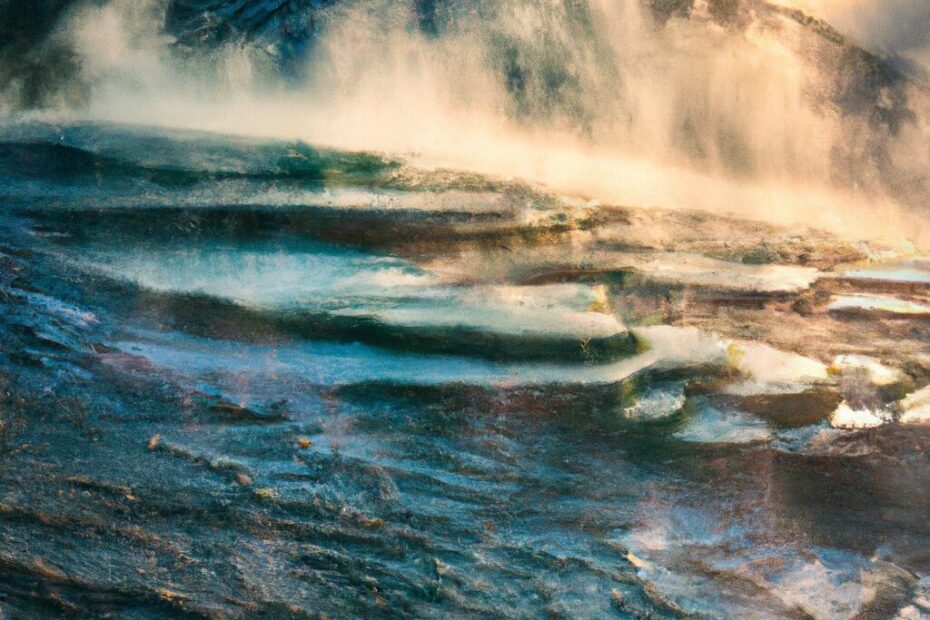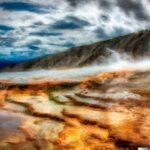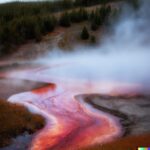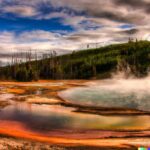Yellowstone National Park is renowned for its stunning natural beauty, and one of its most fascinating attractions is its hydrothermal features. From geysers to hot springs, these unique formations are the result of volcanic activity beneath the Earth’s surface.
In this article, we will explore the causes and types of hydrothermal features found in Yellowstone, as well as the famous ones that draw visitors from around the world. We will also discuss the potential dangers of these features and provide tips for safely enjoying them while visiting the park. Whether you’re a nature enthusiast or planning a trip to Yellowstone, this article will provide you with valuable insights into the park’s remarkable hydrothermal wonders.
What Are Hydrothermal Features?
Yellowstone’s hydrothermal features are unique geological formations that result from the park’s volcanic activity and geologic processes.
Yellowstone National Park boasts a diverse range of geothermal features, including geysers, hot springs, mud pots, and fumaroles. Each of these natural wonders has its own distinct characteristics, making them a must-see for visitors.
Geysers, such as the famous Old Faithful, shoot columns of water and steam into the air, creating a spectacular sight. Hot springs, on the other hand, are known for their vibrant colors, thanks to the presence of thermophilic microorganisms. Mud pots, with their bubbling and churning boiling mud, are a result of the interaction between water and volcanic gases. And fumaroles release steam and gases with intense heat.
It’s important to preserve these geothermal features as they play a crucial role in the park’s unique ecosystem. They provide a habitat for specialized organisms that have adapted to the extreme conditions found in Yellowstone National Park.
What Causes Hydrothermal Features in Yellowstone?
The formation of hydrothermal features in Yellowstone is primarily attributed to the park’s volcanic activity, which creates a geothermal environment conducive to the emergence of various geologic formations and thermal features.
What Is the Role of Magma in Hydrothermal Features?
Magma plays a significant role in the formation of Yellowstone’s hydrothermal features, as it provides the heat source for the park’s extensive geothermal system. This molten rock, located beneath the Earth’s surface, heats groundwater and creates the conditions necessary for the emergence of hot springs, geysers, and fumaroles.
These unique geologic formations and geothermal features are characteristic of the park and are a result of the intricate relationship between magma activities and the park’s hydrothermal system. Geothermal exploration and studies in Yellowstone have further highlighted this relationship, offering valuable insights into the dynamics of geothermal systems and contributing to our understanding of Earth’s geologic processes.
How Does Water Play a Role in Hydrothermal Features?
Water serves as a crucial element in shaping Yellowstone’s hydrothermal features, contributing to the formation of geysers, hot springs, thermal pools, and other geothermal phenomena within the park’s unique hydrological and geothermal environment.
Yellowstone National Park is home to some of the most intriguing natural wonders on Earth. Its unique combination of hot water and heat from the Earth’s interior creates the perfect environment for these captivating features to emerge.
The park’s diverse array of hydrothermal features is a result of the complex interactions between hot water, underground geological structures, and microbial activity. By studying the intricate processes of water circulation, mineral deposition, and hydrothermal activity, we can begin to unravel the mysteries of Yellowstone’s geothermal landscape.
What Are the Different Types of Hydrothermal Features in Yellowstone?
Yellowstone showcases a diverse array of hydrothermal features, including geysers, hot springs, thermal pools, mud pots, and fumaroles, each representing unique geologic formations and natural wonders shaped by the park’s geothermal heat and volcanic features.
These hydrothermal features have distinct characteristics that make them fascinating to observe. Geysers, such as the iconic Old Faithful, erupt periodically with impressive displays of boiling water and steam. Hot springs display vibrant colors due to the presence of thermophilic bacteria, while thermal pools offer serene and often otherworldly landscapes. Mud pots bubble and gurgle with bubbling mud, and fumaroles release steam and gas, creating an otherworldly atmosphere. The geothermal heat underlying these formations continually shapes and evolves the landscape, making Yellowstone a unique and dynamic natural wonder.
What Are the Most Famous Hydrothermal Features in Yellowstone?
Yellowstone is renowned for its iconic hydrothermal features, with notable attractions like Old Faithful Geyser, Grand Prismatic Spring, and Steamboat Geyser captivating visitors with their mesmerizing geothermal displays and natural beauty.
Old Faithful Geyser
Old Faithful Geyser stands as one of Yellowstone’s most iconic and predictable geothermal attractions, captivating visitors with its regular and impressive eruptions, while serving as a symbol of the park’s commitment to environmental conservation and sustainable tourism.
The consistent eruptions of Yellowstone’s geyser occur every 90 minutes, captivating crowds with the power and beauty of geothermal activity. These predictable displays also promote responsible tourism by encouraging visitors to appreciate and respect the natural wonders of the park without causing harm or disruption to the delicate ecosystem.
The geyser’s reliable performance highlights the significance of preserving Yellowstone’s unique geothermal dynamics and reinforces the importance of sustainable environmental practices within the park and beyond.
Grand Prismatic Spring
Grand Prismatic Spring, known for its vibrant colors and expansive beauty, represents a captivating hot spring in Yellowstone that showcases the intersection of geothermal activity, natural wonders, and microbial life in the park’s dynamic geologic landscape.
The unique geological features of Grand Prismatic Spring stem from the presence of thermophilic bacteria and algae that thrive in the spring’s hot, mineral-rich waters. This creates a visually stunning display of vibrant colors, ranging from deep blue in the center to various shades of green, yellow, and orange towards the edges.
This striking coloration is a result of the pigmented microbes which have adapted to the extreme conditions. Their presence adds to the allure and fascination of this natural wonder.
Mammoth Hot Springs
Mammoth Hot Springs in Yellowstone offers a striking display of thermal pools, mineral deposits, and intricate geologic formations. These natural wonders are shaped by the park’s geothermal activity and unique hydrothermal processes.
The diverse array of thermal pools at Mammoth Hot Springs ranges in colors from vibrant oranges, yellows, and greens to brilliant blues. Each pool is colored by different types of thermophilic bacteria thriving in the scalding waters.
The mineral deposits left behind by the constantly flowing water have built up into otherworldly terraces. These terraces resemble intricate steps or cascading waterfalls frozen in time. Not only do these mesmerizing formations make Mammoth Hot Springs a must-see destination for geology enthusiasts, but they also serve as a testament to the ongoing geological processes at work within Yellowstone.
Norris Geyser Basin
The Norris Geyser Basin showcases a dynamic blend of geysers and fumaroles, representing a hub of geothermal features that provide valuable insights into the park’s geothermal resources and the complex dynamics of its hydrothermal environment.
These unique geothermal features allow visitors to witness the various stages of geyser activity, from tranquil hot springs to roaring geysers.
The basin’s diverse array of hydrothermal features demonstrates the ever-changing nature of geothermal activity, serving as a living laboratory for researchers studying the complexities of geysers and the interplay of water, heat, and underground geological structures.
Visitors can experience the rapid formation of colorful mineral deposits and the eerie hissing sounds emanating from active fumaroles, offering a fascinating glimpse into the powerful forces at work beneath the Earth’s surface.
Upper Geyser Basin
The Upper Geyser Basin stands as a captivating landscape within Yellowstone, featuring an array of geysers, hot springs, and geothermal wonders that collectively contribute to the park’s allure as a hub for natural wonders and geothermal attractions.
The basin’s geysers, such as the famous Old Faithful, erupt in an awe-inspiring display of nature’s power. The colorful hot springs paint a vibrant and otherworldly landscape, creating a unique environment for visitors to explore.
Walking through the boardwalks, visitors are immersed in the hissing, bubbling, and steaming geothermal features, providing an unforgettable sensory experience. This glimpse into the Earth’s inner workings serves as a testament to the park’s commitment to preserving its natural marvels.
What Are the Dangers of Hydrothermal Features in Yellowstone?
While Yellowstone’s hydrothermal features captivate visitors with their natural beauty and geologic wonders, they also pose inherent dangers, including scalding water, toxic gases, and the presence of unstable ground in certain areas of the park.
Scalding Water
The presence of scalding water in Yellowstone’s hydrothermal areas poses a significant danger to visitors, necessitating stringent safety precautions and adherence to park regulations to mitigate the risks associated with geysers and hot springs.
When visiting Yellowstone National Park, it is important to remember that exposure to boiling water or steam can result in severe burns. Additionally, the ground surrounding these features is often unstable, which can lead to accidents. To stay safe, it is crucial for visitors to stick to designated paths and boardwalks, avoiding venturing off-trail where the thin crust may conceal hazardous thermal features.
To ensure a memorable and injury-free experience, it is essential to heed warning signs and maintain a safe distance from geysers and hot springs. By following these precautions, visitors can fully enjoy the wonders of Yellowstone National Park.
Toxic Gases
The presence of toxic gases in certain hydrothermal areas of Yellowstone poses a risk to visitor safety and underscores the importance of monitoring air quality and obeying park guidelines to mitigate the potential dangers associated with geysers and hot springs.
It is important for visitors to Yellowstone to be aware of the potential dangers posed by toxic gases, such as hydrogen sulfide and carbon dioxide. This is especially crucial for those exploring the park’s unique natural features. Continuous monitoring of air quality in these areas helps to detect high concentrations of these gases early on, reducing the risk of health hazards.
To ensure the safety of visitors and preserve the delicate balance between humans and nature in these hydrothermal zones, it is important to follow park guidelines. This includes staying on designated trails and avoiding closed areas. By doing so, visitors can enjoy the park while minimizing their impact on the environment.
Unstable Ground
The presence of unstable ground in proximity to geysers and hot springs in Yellowstone’s hydrothermal areas necessitates strict adherence to park regulations and designated pathways to ensure visitor safety and minimize the risks associated with the dynamic nature of the park’s geologic landscape.
Visitors must recognize that the ground surrounding geysers and hot springs can be deceptively fragile, and the beauty of these natural features often belies their potential hazards.
Crusts of thin, fragile crust can conceal boiling water or unstable, scalding mud pockets, making it vital for visitors to stay on designated pathways and not venture into restricted areas.
Failure to adhere to these regulations not only places visitors at significant risk but also hampers conservation efforts by disturbing delicate ecosystems.
Park rangers and signage provide crucial guidance, educating visitors about the inherent dangers and preventive measures in these unique environments.
How Can Visitors Safely View and Enjoy Hydrothermal Features in Yellowstone?
To ensure a safe and enjoyable experience while viewing Yellowstone’s hydrothermal features, visitors are advised to stay on designated boardwalks and trails, adhere to park regulations, respect the environment, and be mindful of warning signs and alerts highlighting potential hazards associated with the park’s unique geologic wonders.
Stay on Boardwalks and Trails
Visitors are strongly advised to stay on designated boardwalks and trails when exploring Yellowstone’s hydrothermal areas, as these pathways are carefully designed to ensure visitor safety and protect the park’s unique geologic features in accordance with park regulations.
Designated paths in Yellowstone National Park serve as safe vantage points for observing hot springs, geysers, and mud pots. These paths also play a crucial role in preserving the delicate ecosystem. Staying on the boardwalks and trails helps prevent accidental damage to the thermal features and ensures visitors can marvel at the park’s natural wonders while respecting guidelines.
By following these measures, visitors can fully appreciate the splendor of Yellowstone without posing a risk to themselves or the environment.
Follow Park Regulations
Adherence to park regulations is essential for visitor safety and environmental conservation when exploring Yellowstone’s hydrothermal features. This underscores the need to respect designated guidelines and preserve the park’s natural wonders for future generations.
This responsibility extends to all visitors who marvel at the breathtaking geysers, colorful hot springs, and diverse thermal features. By following established rules, visitors contribute to the preservation of this unique ecosystem, minimizing the risk of accidents and ensuring that these natural marvels remain unspoiled.
Understanding the significance of these regulations enhances the experience for all and fosters a sense of environmental stewardship, an integral aspect of enjoying and protecting the park’s captivating landscapes.
Be Aware of Warning Signs and Alerts
Visitors must remain vigilant and heed warning signs and alerts provided within Yellowstone’s hydrothermal areas, as these indicators serve to communicate potential hazards and ensure visitor safety in alignment with park regulations and guidelines.
These cautionary measures are crucial for maintaining the well-being of everyone who explores the park’s unique geothermal features.
Ignoring these warning signs can put individuals at risk of encountering hot springs, geysers, or unstable ground, which could lead to severe injuries.
By paying close attention to these indicators, visitors demonstrate their commitment to responsible exploration and contribute to the preservation of the park’s natural wonders.
It is imperative that all visitors familiarize themselves with safety precautions and adhere to the guidance provided by park authorities.
Respect the Environment
Respecting the environment and preserving the natural habitat of Yellowstone’s hydrothermal areas is imperative to ensure the longevity and integrity of the park’s geologic wonders. This emphasizes the responsibility of visitors in promoting environmental conservation and stewardship.
“By maintaining a respectful distance from the delicate ecosystems and refraining from disrupting the natural processes,” visitors can play a crucial role in safeguarding the biodiversity and ecological balance.
It is essential for visitors to adhere to designated trails, adhere to waste management guidelines, and contribute to ongoing preservation efforts. Protecting the hydrothermal features and their surrounding areas acknowledges their immense value and aids in preserving the natural habitat for the benefit of future generations.
Frequently Asked Questions
What are the most famous geysers in Yellowstone National Park?
The most famous geysers in Yellowstone are Old Faithful, Grand Geyser, and Castle Geyser.
How often does Old Faithful erupt?
Old Faithful erupts approximately every 90 minutes, give or take 10 minutes.
What makes Yellowstone’s geysers and hydrothermal features unique?
Yellowstone sits on top of a supervolcano, creating a large concentration of geysers and other hydrothermal features.
Are there any dangers associated with visiting Yellowstone’s geysers and hydrothermal features?
Yes, there are several dangers including scalding water, unpredictable eruptions, and toxic gases. It’s important to always follow park safety guidelines.
Can you swim in any of the geysers or hot springs in Yellowstone?
No, swimming in any of Yellowstone’s geysers or hot springs is strictly prohibited. The water is extremely hot and can cause severe burns.
Do Yellowstone’s geysers and hydrothermal features have any impact on the surrounding environment?
Yes, these features play a vital role in the park’s unique ecosystem. They provide nutrients for plants and support a variety of microorganisms that are essential for the ecosystem’s health.
Last Updated on January 25, 2024 by Jon Waraas – Originally Posted: January 25, 2024

I’m Jon Waraas, and I’ve been navigating the online world since 2006. By day, I’m the proud owner of some eCommerce gems, and by night, I’m the voice behind the adventures on Waraas.Com.
My heart, however, belongs to the wild beauty of Yellowstone National Park. I’ve got a collection of websites dedicated to sharing the wonders of this natural masterpiece. Oh, and did I mention? I’m currently building my own cabin inside the ghost town of Gilmore, Idaho – a cabin with tales to tell!
When I’m not immersed in the digital realm, you’ll find me lacing up my boots for a good hike or setting up camp under the star-studded sky.




